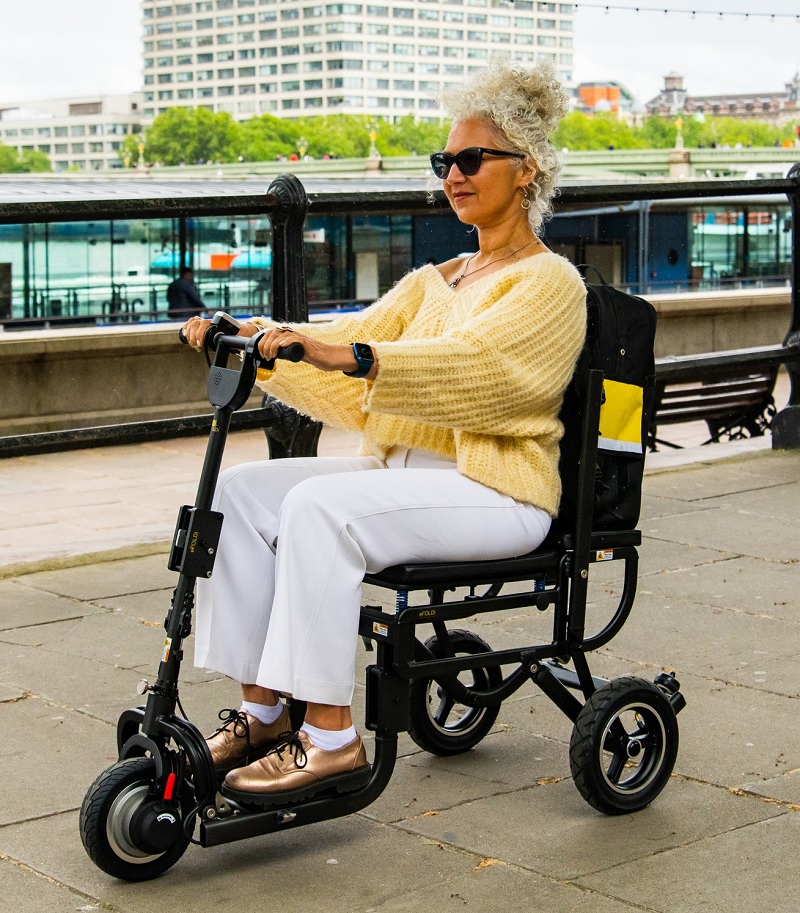Background:
With the steep rise in energy costs sending ripples through the world economy, it has led to what some commentators are calling, a ‘cost-of-living’ crisis. Yet, for many people living with mobility impairments, maintaining a suitable level of independence is fundamental to their quality of life and well-being. This means battery-powered devices like mobility scooters and power chairs can often be regarded as essential aids to help support the demands of everyday living. But, with energy bills increasing, what should consumers be considering when selecting their next mobility device, given the vast array of choices on offer and varying levels of total cost of ownership.

Despite the huge variety of devices available, no two electric scooters or powered wheelchairs are the same, in terms of their relative performance and energy efficiency. Consumers must first decide what their key requirements are, and this may mean having to make some trade-offs in respect to balancing levels of functionality versus comfort and convenience to some extent – within the constraints of their budgets and considerations around their physical ability. But with the rises in the costs of domestic energy likely to continue, consumers may also now want to consider ‘energy consumption’ when selecting the right mobility product for their needs. Here, we attempt to tackle some of the most common questions in relation to ‘energy efficiency’ which will impact your running costs and the total cost of ownership for users of mobility scooters and powered wheelchairs.
Your questions answered – mobility equipment, energy efficiency, and total costs of ownership.
1. Which type of batteries are used in mobility scooters and powered wheelchairs?
For scooters and power chairs, traditionally, the most common type of battery used is lead-acid, and these generally come in 3 different variants – Sealed lead-acid, AGM (Absorbed Glass Matting) and Gel. In practice, sealed-lead acid batteries are most often used in scooters and Gel batteries are more commonly found in powered wheelchairs. In more recent years, however, significant advances in battery technology have meant that lithium or lithium-Ion (Li-ion) batteries are becoming increasingly popular, particularly as more and more manufacturers start to adopt lithium technology because of the various performance advantages they can provide. Despite being a relatively new technology, it’s worth noting, that lithium batteries are far more universally used nowadays in both industrial and domestic settings. In fact, lithium batteries can now be found in all manner of consumer devices, from mobile phones to electric motor vehicles. Notably, Tesla, the number one global electric vehicle brand uses lithium-ion batteries to power its vehicles.
2. What are the advantages and disadvantages of the various types of batteries used in mobility equipment?
As well as outright cost, the different types of batteries offer varying levels of performance in terms of a number of variables, the main ones being – lifespan, range (the distance they can travel) and reliability, charging times as well as relative size and weight.
Battery lifespan:
In terms of expected lifespan, lithium batteries, like the ones used in eFOLDi products, are likely to continue working effectively for up to around 1,000 cycles or charges – if not more. This should offer many years of use, in most circumstances, whereas with lead-acid batteries, they’ll probably need replacing every 12 to 18 months, according to a report by the Research Institute for Disabled Consumers. Obviously, replacement creates an additional level of cost as well as further hassle for users who must arrange call-outs and have their lead-acid batteries changed more frequently. Users should also ensure they dispose of their batteries through an approved source, according to local government guidelines.
With regards to ongoing maintenance, sealed lead-acid batteries will also typically require some level of maintenance throughout their lifetime and users should also apply a level of care when charging a sealed lead-acid battery. AGM and Gel batteries less so, and they generally cost more as a result. Misuse or inadequate charging practices, like over-charging, can decrease operational lifespan and this will mean you might need to replace your lead-acid, AGM or Gel batteries more frequently. In comparison, lithium batteries require little or no maintenance meaning they are hassle-free. Users should, however, always refer to their user manual for any specific operating instructions on how best to charge and maintain their battery and/or device.
Battery range and reliability:
Gel batteries generally provide a greater range than AGM batteries, but still less than lithium. Because of their unique chemistry and superior energy density, lithium batteries are proven to be more efficient in terms of the way they store energy. Lithium batteries also have much more ‘usable’ capacity than lead-acid batteries. This means the battery will keep working longer until it’s nearly flat, unlike lead-acid batteries which will more than likely stop working at about 50% of their overall capacity. A report by the Research Institute for Disabled Consumers, suggests users of devices with lead-acid batteries should plan on travelling about half the manufacturer’s stated range in between charges, to avoid being stranded unnecessarily. With lithium batteries, they are expected to retain around 80% of their capacity with some, even after 700 charges. With lead acid batteries, you won’t benefit from their full stated capacity and their capacity diminishes to a far greater extent over time, as you continue to charge them.
Battery charging times:
Lead-acid batteries are well known to take a long time to charge, indeed most lead-acid batteries can take more than 10 hours to fully charge because of their internal design.
Lithium batteries, in comparison, can be fully charged in as little as 2-3 hours depending on the size of the battery and type of charger. Due to their unique chemistry and their respective energy density, lithium batteries can accept a faster rate of current, so they charge much quicker than batteries made with lead acid, AGM or Gel. This makes lithium batteries much more convenient to use, and you don’t have to rely on regular overnight charging.
Battery size and weight:
Because of their unique chemical make-up, lithium batteries have a far greater energy density so they can store more energy, in the same amount of space. This makes lithium batteries extremely lightweight, compared to traditional battery technologies like lead-acid. In fact, lithium batteries can weigh around half that of a lead-acid battery. This means devices like scooters and powered wheelchairs often weigh less and run for longer because they use up less energy when powered by lithium batteries. Being lightweight, also means lithium batteries can be removed easily and even carried by users so they are portable too.
3. How do the costs of ownership compare for the various types of batteries?
All types of batteries differ in respect to their upfront cost, but that initial cost can often be offset by the total length of operational life. Some types of batteries may cost much less initially, but they may then need replacing more frequently than others. Call-outs for battery replacement can be expensive, inconvenient and time-consuming, so users should always consider the total cost of ownership, when weighing up the various options.
From an initial cost perspective, sealed lead-acid, AGM or gel batteries will very often cost far less to purchase than lithium batteries, which means the devices they are used in can often appear to be a more cost-effective alternative. However, when you start looking at the relative costs in terms of the total power or range those batteries provide, lithium battery technology will very often be the most cost-effective option – by far. Lithium batteries are proven to be more efficient in terms of the way they store energy, so they need less space – hence they are often much smaller and lighter than lead-acid batteries. Lead-acid batteries can weigh up to 10 times more than lithium batteries. More weight means greater demands on the battery which leads to a reduction in the total range or the distance those devices can travel on one charge. Essentially, this means the resultant ‘cost per mile’ is far greater for those devices using lead-acid batteries. For eFOLDi products, like the Lite, Explorer and Power Chair models, their running costs equate to less than 1p per mile of use – which is excellent value!
4. Will you be able to travel on planes with scooters and powered wheelchairs that use lead acid or lithium batteries?
Yes, in most cases, both lead-acid and lithium batteries can be transported by aeroplane, provided certain safety requirements are met. Your battery or wheelchair supplier can provide an approved IATA Certificate to prove that they are safe for air travel. Some batteries may also be marked on top with a sticker stating they are IATA approved.
Airlines will usually ask users to carry their scooter or wheelchair battery with them in their carry-on luggage. This means batteries will need to be removable and ideally not too heavy, so they are easy to carry around.
Many eFOLDi users benefit by having the freedom to travel overseas because their eFOLDi Scooters or Power Chairs are designated as ‘Airsafe’.
The full list of requirements is detailed within the IATA Dangerous Goods Regulations, and this is based on the ICAO Technical Instructions. For more information about the IATA requirements, please see some guidance here.
5. What can affect battery performance?
There are a number of factors that impact battery performance, but it will depend on the type of battery that is being used. In general, however, the weight of the device or the user, ambient temperatures, tyre pressures and terrain can all affect the relative performance of a battery in a scooter or powered wheelchair.
The lighter the user, the more range the battery will have as it requires less power. Similarly, if you carry a lot of shopping or baggage with you, this can increase the load on the battery which can then reduce the range you can travel.
Ambient temperatures above 35 degrees Celsius and below freezing, will also negatively affect the range and the performance of the battery.
If the terrain is abnormally rough or includes a lot of hills, this can again reduce the overall range of the mobility device can travel.
It is also important to maintain the right tyre pressures on mobility devices (if relevant) to ensure you maximise the battery life of your scooter or wheelchair.
In some cases, the age and condition of the battery will also impact the level of performance. Lead-acid batteries, in particular, tend to gradually lose overall battery capacity over-time, and will likely need to be replaced typically every 12 to 18 months to ensure they continue to work as expected.
If batteries are poorly maintained or not charged according to manufacturers’ guidelines, this can also limit the lifespan and the overall performance of your mobility device battery.
6. How can you get the best out of your batteries?
There are several ways to ensure you keep your batteries in tip-top condition. This includes the following:
- Always follow the guidance contained within the device user manual, particularly with regards to how to charge and store your battery
- Only charge your batteries with the approved charger unit
- Do not use a modified or damaged charger
- Never place the battery near, on or against any heat source
- Ensure no metal parts can touch (or ‘short’) battery or charger terminals, connectors, pins or any other electrical conductor(s) or conducting parts
- Avoid excessive physical impact and vibration of the battery
- Do not attempt to dismantle, dissect or deform the battery(ies) or case(s)
- Do not immerse the battery in any liquid (including water)
- Always store your battery in a cool, dry, well-ventilated area
- Dispose of the battery only in accordance with local laws and/or regulations
- Arrange regular servicing and maintenance of your scooter or wheelchair with a recognised service agent or the device manufacturer (where relevant)
7. What is the best battery or mobility device for you?
That really depends on your budget and how to intend to use your mobility device. Scooters and powered wheelchairs come in a variety of different forms. Some scooters, for instance, can be used on roads (Class III), others are not permitted on roads, only pavements (Class II). Other devices are even meant to be run off-road on more challenging terrain. Some are also designed to be more portable and can be folded up so they can be transported in cars, ships, trains and planes. So, you really need to consider whether you require your device for general day-to-day use only, or do you want to travel with your device in the car or on a plane for holidays and day trips away?
Start out by defining what you want your device to do, how often and where you expect to use it. You also need to consider whether the mobility device and therefore the battery that you will use, will be suitable according to your physical mobility and the expected levels of use.
Always arrange a product demonstration so you can test out the equipment to see if it will suit your exact needs.
Finally – it’s important to also weigh up the initial cost of purchase, alongside the on-going running costs and the total cost of ownership – especially with rising energy costs in mind.






